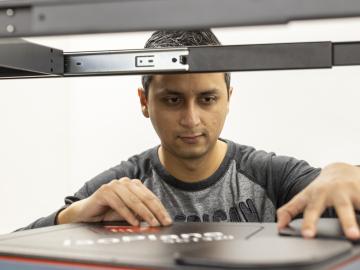
Filter News
Area of Research
- (-) Advanced Manufacturing (6)
- (-) Biological Systems (1)
- (-) Neutron Science (79)
- (-) Nuclear Science and Technology (13)
- (-) Supercomputing (43)
- Biology and Environment (25)
- Computational Biology (2)
- Computational Engineering (1)
- Computer Science (4)
- Energy Science (25)
- Fusion and Fission (17)
- Fusion Energy (11)
- Isotopes (6)
- Materials (57)
- Materials for Computing (11)
- National Security (11)
- Quantum information Science (1)
- Transportation Systems (1)
News Type
News Topics
- (-) Artificial Intelligence (25)
- (-) Biomedical (21)
- (-) Fusion (9)
- (-) Materials Science (23)
- (-) Neutron Science (80)
- (-) Physics (7)
- (-) Security (3)
- 3-D Printing/Advanced Manufacturing (18)
- Advanced Reactors (10)
- Big Data (20)
- Bioenergy (9)
- Biology (9)
- Biotechnology (1)
- Buildings (2)
- Chemical Sciences (4)
- Clean Water (2)
- Composites (3)
- Computer Science (64)
- Coronavirus (11)
- Critical Materials (3)
- Cybersecurity (2)
- Energy Storage (6)
- Environment (22)
- Exascale Computing (17)
- Fossil Energy (1)
- Frontier (18)
- Grid (1)
- High-Performance Computing (28)
- Hydropower (1)
- Isotopes (4)
- Machine Learning (11)
- Materials (17)
- Mathematics (2)
- Microscopy (3)
- Molten Salt (4)
- Nanotechnology (8)
- National Security (3)
- Nuclear Energy (31)
- Polymers (3)
- Quantum Computing (15)
- Quantum Science (15)
- Simulation (13)
- Software (1)
- Space Exploration (8)
- Summit (28)
- Transportation (6)
Media Contacts

Research by an international team led by Duke University and the Department of Energy’s Oak Ridge National Laboratory scientists could speed the way to safer rechargeable batteries for consumer electronics such as laptops and cellphones.

Scientists have tapped the immense power of the Summit supercomputer at Oak Ridge National Laboratory to comb through millions of medical journal articles to identify potential vaccines, drugs and effective measures that could suppress or stop the

With Tennessee schools online for the rest of the school year, researchers at ORNL are making remote learning more engaging by “Zooming” into virtual classrooms to tell students about their science and their work at a national laboratory.

In the race to identify solutions to the COVID-19 pandemic, researchers at the Department of Energy’s Oak Ridge National Laboratory are joining the fight by applying expertise in computational science, advanced manufacturing, data science and neutron science.

As a teenager, Kat Royston had a lot of questions. Then an advanced-placement class in physics convinced her all the answers were out there.

Oak Ridge National Laboratory researchers working on neutron imaging capabilities for nuclear materials have developed a process for seeing the inside of uranium particles – without cutting them open.

A versatile class of flexible, protein-like polymers could significantly advance future drug delivery methods. But first, scientists have to develop a reliable process for tailoring these polymers into shapes that can effectively transport medicines throughout the human body.

The techniques Theodore Biewer and his colleagues are using to measure whether plasma has the right conditions to create fusion have been around awhile.

Biological membranes, such as the “walls” of most types of living cells, primarily consist of a double layer of lipids, or “lipid bilayer,” that forms the structure, and a variety of embedded and attached proteins with highly specialized functions, including proteins that rapidly and selectively transport ions and molecules in and out of the cell.



